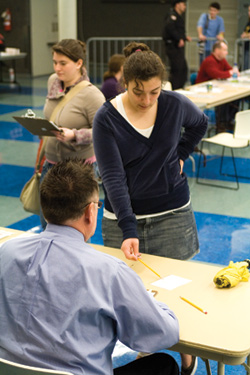 Scott Bressler
Scott BresslerUniversity administrators, St. Louis Department of Health officials and more than 200 campus volunteers collaborated in a public health drill Tuesday that simulated the distribution of medication at Mallinckrodt in the event of a terrorist anthrax attack, and tested the University’s emergency text-message system.
“We have protocols in place for a public health event, but we’ve never tried them and we haven’t trained a lot of people,” said Mark Bagby, the University emergency coordinator. “We came up with a very simplistic protocol [for responders to follow].”
The faculty, staff and students who volunteered to participate in the event were given a story to tell as they proceeded through the simulation, which was held in the Gargoyle.
During the drill, faculty and staff-including professors and administrators-were given an algorithm that helped them to identify symptoms in the volunteers and dispense medication to them. In a real-life scenario, qualified medical personnel would oversee the distributors.
The success of the distributors was measured against predetermined University and county health criteria.
“We’ll be able to track the forms to see if they made the right choices,” said Bagby.
The drill was held at the University because it is considered to be a place where mass mobility could be limited in the event of a disaster. Elsewhere in St. Louis, people showing symptoms of an epidemic would go to open public points of distribution (PODS), such as high schools, community centers and government sites.
Two observers from the St. Louis Department of Health were also present at the drill to give the University feedback on its response.
“We would be considered partners [with the University],” said Saralou Hendrickson, Bioterrorism and Emergency Response Planner for the City of St. Louis department of health. “It is our responsibility to make sure that people receive medication if they are exposed to a biological agent.”
In the drill scenario, an anthrax attack was said to be detected during the St. Patrick’s Day Parade on Monday. The simulation was meant to model “Day Two” of the attack.
Students from the Emergency Support Team (EST) were also present at the simulation in order to familiarize them with University disaster protocol.
“It’s been part of our mission to provide emergency medical services to campus in the event of a disaster,” said Eric LeFebvre, a senior and EST field director. “There are no written plans to utilize the team in a disaster, however the team has been working closely with the administration to formalize our role.”
“If this happened, this is the role we would be doing, so this is a good way for us to train,” said Jessalin Schultz, a senior and EST disaster coordinator.
This was the first time that a public health drill of this scale was carried out at the University.
In addition to the POD simulation, University administrators tested the WUText Emergency Notification System for the first time campus-wide. Students registered for the service received mock text messages informing them of an emergency test.
According to Bagby, the success of WUText could not be measured directly, but an online poll was being used to determine if students received the messages.
For more information on disaster protocol, visit emergency.wustl.edu.
-With additional reporting by Sam Guzik